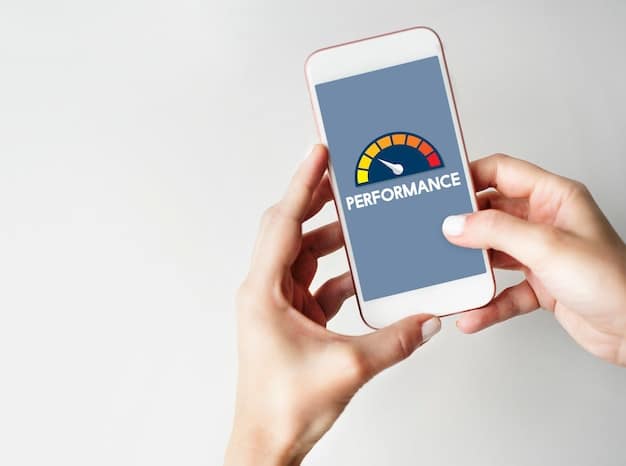Mobile-First Indexing in 2025: Strategies for Seamless User Experience

Mobile-first indexing prioritizes the mobile version of a website for indexing and ranking, necessitating a focus on responsive design, mobile site speed, and optimized content to ensure a seamless user experience across all devices in 2025.
Is your website ready for mobile-first indexing in 2025: ensuring a seamless user experience on all devices? With Google prioritizing mobile versions for indexing and ranking, it’s crucial to adapt your digital marketing strategies now to stay ahead in the search results.
Understanding Mobile-First Indexing
Mobile-first indexing means Google primarily uses the mobile version of a website for indexing and ranking. This significant shift emphasizes the importance of optimizing your site for mobile devices.
Understanding why this change occurred and its implications are vital for any website owner or digital marketer.
The Shift to Mobile
The shift happened because most people now access the internet via mobile devices. Google recognized this trend and adapted its indexing process to reflect user behavior.
Why Mobile-First Indexing Matters
Failing to optimize for mobile-first indexing can lead to lower rankings and reduced visibility in search results. This directly impacts traffic, user engagement, and overall business success.
Understanding the core principles is crucial for adapting effectively.
- Website Speed: Mobile users expect fast loading times.
- Responsive Design: Your site should adapt seamlessly to different screen sizes.
- Content Optimization: Mobile content should be concise and user-friendly.
Staying informed ensures a smooth transition and continued success in the digital landscape.

In essence, mobile-first indexing is about catering to how the majority of users access the web and it’s pivotal for maintaining a strong online presence.
Optimizing for Mobile Site Speed
Site speed is critical for mobile users. Slow loading times can lead to high bounce rates and poor user engagement.
Optimizing your site speed involves several key strategies and practices.
Implementing Accelerated Mobile Pages (AMP)
AMP provides a streamlined version of your website, designed for fast loading times on mobile devices. This can significantly improve user experience.
Compressing Images and Files
Large images and files slow down your site. Compressing these resources reduces load times and improves overall performance.
Caching mechanisms are essential for enhancing mobile site speed.
- Browser Caching: Allows browsers to store static files, reducing the need to reload them on subsequent visits.
- Server-Side Caching: Stores frequently accessed data on the server, delivering content faster.
- Content Delivery Networks (CDNs): Distribute your content across multiple servers globally, ensuring faster delivery to users regardless of their location.
Optimizing for mobile site speed not only improves user experience but also boosts your site’s search engine ranking.

By focusing on these optimization techniques, you ensure a smoother, faster mobile experience, which is critical for retaining users and achieving higher search rankings.
Ensuring a Responsive Website Design
A responsive design ensures your website adapts seamlessly to different screen sizes and devices. This is crucial for providing a consistent user experience.
Responsive design involves several key elements and strategies.
Using Flexible Layouts
Flexible layouts adjust the positioning and sizing of elements based on the screen size. This ensures readability and ease of navigation on any device.
Implementing Media Queries
Media queries allow you to apply different styles based on the characteristics of the device. This ensures your website looks and functions optimally on all screens.
Testing is a vital part of maintaining a responsive website design.
- Cross-Device Testing: Regularly test your website on various devices and screen sizes.
- User Feedback: Collect feedback from users to identify and address any usability issues.
- Automated Tools: Utilize tools like BrowserStack and Responsinator to simulate different devices.
By prioritizing responsive design, you ensure inclusivity and accessibility for all users, regardless of their device.
Responsive design is not just about aesthetics; it’s also about functionality and usability, crucial for retaining visitors and driving engagement.
Optimizing Content for Mobile Devices
Content optimization for mobile devices involves creating concise, user-friendly content that caters to mobile users’ needs.
Effective mobile content optimization encompasses several essential practices.
Using Concise Language
Mobile users often skim content. Use concise language and clear headings to convey your message effectively.
Prioritizing Key Information
Place the most important information at the beginning of your content to capture users’ attention immediately.
Navigation plays a crucial role in mobile content optimization.
- Simplified Menus: Use dropdown menus or hamburger icons to keep navigation clean and straightforward.
- Clear Calls-to-Action: Make calls-to-action prominent and easy to tap.
- Internal Linking: Use internal links to guide users to related content and improve engagement.
Optimizing content for mobile devices not only enhances user experience but also improves your site’s ranking in mobile search results.
By focusing on conciseness, prioritization, and intuitive navigation, you can significantly improve the mobile user experience, leading to higher engagement and conversion rates.
Leveraging Structured Data Markup
Structured data markup helps search engines understand the content on your website, improving its visibility and click-through rates.
Effective structured data implementation involves several key steps.
Implementing Schema Markup
Schema markup provides detailed information about the content on your pages, such as articles, products, and events. This helps search engines display rich snippets.
Using JSON-LD Format
JSON-LD is a lightweight format that is easy to implement and maintain. It’s recommended by Google for structured data markup.
Validation ensures the accuracy and effectiveness of the data.
- Google’s Rich Results Test: Use Google’s tool to check if your structured data is implemented correctly.
- Schema Markup Validators: Utilize online validators to identify and fix any errors in your markup.
- Regular Audits: Regularly audit your structured data to ensure it remains valid and up-to-date.
By leveraging structured data markup effectively, you enhance your site’s visibility and attract more relevant traffic from search engines.
Structured data isn’t just about telling search engines what your content is; it’s about making your content more appealing and informative to potential visitors, ultimately driving more clicks and engagement.
Monitoring and Analyzing Mobile Performance
Regular monitoring and analysis of your mobile performance are essential for identifying areas for improvement and ensuring continued success.
Effective monitoring involves tracking several key metrics and using the right tools.
Tracking Key Performance Indicators (KPIs)
Monitor KPIs such as mobile traffic, bounce rate, page load time, and conversion rates to assess your mobile performance.
Using Google Analytics
Google Analytics provides valuable insights into user behavior on mobile devices. Use it to track traffic sources, engagement metrics, and conversion goals.
Analyzing data helps refine strategies and tactics.
- User Behavior Analysis: Understand how users interact with your mobile site to identify areas for improvement.
- A/B Testing: Conduct A/B tests to optimize page layouts, content, and calls-to-action.
- Performance Benchmarking: Compare your mobile performance against industry benchmarks to identify opportunities for growth.
By consistently monitoring and analyzing your mobile performance, you ensure your website remains optimized for mobile-first indexing and delivers a seamless user experience.
Monitoring and analytics aren’t just about collecting data; they’re about understanding user behavior and using those insights to make informed decisions that improve performance and drive results.
| Key Point | Brief Description |
|---|---|
| 🚀 Site Speed | Fast loading times are crucial for mobile users to reduce bounce rates. |
| 📱 Responsive Design | Ensures your site adapts to various screen sizes for consistent UX. |
| ✍️ Content Optimization | Concise and user-friendly content for on-the-go mobile users. |
| 📊 Monitoring | Regularly analyze mobile performance for continuous improvement. |
Frequently Asked Questions
▼
Mobile-first indexing means Google primarily uses the mobile version of a website for indexing and ranking, reflecting the dominance of mobile internet usage.
▼
Use Google’s Mobile-Friendly Test tool. Enter your URL, and it will analyze your site’s mobile-friendliness and provide recommendations for improvements.
▼
Site speed is crucial because mobile users expect fast loading times. Slow loading times can lead to higher bounce rates and negatively impact search rankings.
▼
Responsive design ensures your website adapts seamlessly to different screen sizes. It is important for providing a consistent UX and preventing ranking drops.
▼
Structured data assists search engines in understanding your content, improving visibility and CTR by producing rich snippets; JSON-LD format is preferred for easy setup.
Conclusion
Preparing for mobile-first indexing in 2025 is essential for maintaining and improving your website’s visibility and user experience. By focusing on site speed, responsive design, content optimization, structured data, and consistent monitoring, you can ensure your site is well-positioned to succeed in the mobile-first era.





